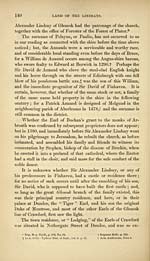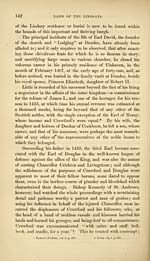Download files
Complete book:
Individual page:
Thumbnail gallery: Grid view | List view

FINHAVEN — THE CRAWFORD BURIAL PLACE. 141
tensive, that it stretched from thence south to the river Tay, and
being entered by a massive gateway, on which there was a battle-
ment bearing the legend — "Datu'ti SorO HinDgag, lEarl of ©rafoforti"
— it had altogether a fine princely appearance.* It is probable
that the property on which this palace stood was owned by
the first Earl's uncle, " the good Sir James," as he founded a
Convent in Dundee for the ransom of Christian Captives from
Turkish slavery, which ultimately assumed the character of an
hospital, and its revenues, originally " princely magnificent,"
were enlarged by a gift of the church of Kettins, near Cupar in
Angus, from Robert III.
The attachment of the Earls of Crawford to Dundee as a
burial place, may have arisen from the circumstance of Sir
James' favour for it, or from the interest which they had in the
great customs or revenues of the burgh ; or, it may have been
from the foundation of a church and tower on the rock of Saint
Nicholas by the first Earl on his return from the overthrow of
Lord Welles at the famous tournament at London Bridge. This
rock is said to have been the site of the original church of
Dundee, or of that which was founded by the Earl of Huntingdon
in fulfilment of a vow which he made while his life was en-
dangered in the crazy prow which landed him here on his return
from the holy wars ; but all trace of this, as well as of Craw-
ford's church and tower, are gone, and the rock itself is sorrily
represented by a mere fragment. This, however, was not the
place of the Crawford sepulture, it being within the church of
the Greyfriars, which stood in the Houff, or old burial place ;
and, from the time of the first Earl, down to that of the
demolition of their tombs by the fanatics of the sixteenth
century, it was the last cold home of most of the Lords and
Ladies of Crawford, including the renowned Earl Beardie, and
his son the Duke of Montrose. But, from the period of the
sacrilegious breaking down of the fine stone effigies, and Gothic
archways and columns, and the scattering of the bones of their
ancestors, their future place of interment was within the fine
church of St. Mary in the same town, which was completely
destroyed by the conflagration of 1841,j" and no trace either
* Lives, vol. i. p. 110.
t Vide Thomson's History of Dundee for an account of this burning, and for ecclesiastical
and other antiquities.
tensive, that it stretched from thence south to the river Tay, and
being entered by a massive gateway, on which there was a battle-
ment bearing the legend — "Datu'ti SorO HinDgag, lEarl of ©rafoforti"
— it had altogether a fine princely appearance.* It is probable
that the property on which this palace stood was owned by
the first Earl's uncle, " the good Sir James," as he founded a
Convent in Dundee for the ransom of Christian Captives from
Turkish slavery, which ultimately assumed the character of an
hospital, and its revenues, originally " princely magnificent,"
were enlarged by a gift of the church of Kettins, near Cupar in
Angus, from Robert III.
The attachment of the Earls of Crawford to Dundee as a
burial place, may have arisen from the circumstance of Sir
James' favour for it, or from the interest which they had in the
great customs or revenues of the burgh ; or, it may have been
from the foundation of a church and tower on the rock of Saint
Nicholas by the first Earl on his return from the overthrow of
Lord Welles at the famous tournament at London Bridge. This
rock is said to have been the site of the original church of
Dundee, or of that which was founded by the Earl of Huntingdon
in fulfilment of a vow which he made while his life was en-
dangered in the crazy prow which landed him here on his return
from the holy wars ; but all trace of this, as well as of Craw-
ford's church and tower, are gone, and the rock itself is sorrily
represented by a mere fragment. This, however, was not the
place of the Crawford sepulture, it being within the church of
the Greyfriars, which stood in the Houff, or old burial place ;
and, from the time of the first Earl, down to that of the
demolition of their tombs by the fanatics of the sixteenth
century, it was the last cold home of most of the Lords and
Ladies of Crawford, including the renowned Earl Beardie, and
his son the Duke of Montrose. But, from the period of the
sacrilegious breaking down of the fine stone effigies, and Gothic
archways and columns, and the scattering of the bones of their
ancestors, their future place of interment was within the fine
church of St. Mary in the same town, which was completely
destroyed by the conflagration of 1841,j" and no trace either
* Lives, vol. i. p. 110.
t Vide Thomson's History of Dundee for an account of this burning, and for ecclesiastical
and other antiquities.
Set display mode to:
![]() Universal Viewer |
Universal Viewer | ![]() Mirador |
Large image | Transcription
Mirador |
Large image | Transcription
Images and transcriptions on this page, including medium image downloads, may be used under the Creative Commons Attribution 4.0 International Licence unless otherwise stated. ![]()
| Histories of Scottish families > History and traditions of the land of the Lindsays in Angus and Mearns > (159) Page 141 |
|---|
| Permanent URL | https://digital.nls.uk/94870934 |
|---|
| Description | A selection of almost 400 printed items relating to the history of Scottish families, mostly dating from the 19th and early 20th centuries. Includes memoirs, genealogies and clan histories, with a few produced by emigrant families. The earliest family history goes back to AD 916. |
|---|

